
A Time Line
The United States Navy
Deployment of the Tenders
They say the what goes around - comes around --
The US Navy started with 2 Tenders near the start of the century -- and ended the century with 2 Tenders...
The US's deployment of it's new submarine weapon started on both coasts (the Long Island Sound and Mare Island, San Francisco) but quickly spread.
A few notes about the Tender TimeLine:
The new 4th Dimension Database and chart program:
We have implemented a database of Tender Bases and Deployments - and using 4D's programming language - have written custom routines to chart that data into a graphic form. As a result - the Tender TimeLine now has a resolution of one month vs. the previous one year - providing a much clearer track of the tenders as they fulfilled their missions. While the database is much more complete than before -- the history record for many ships is incomplete - so there are likely gaps in the time line where the known history is silent. As we get more stuff - we'll try to update the time line accordingly. And like any human endevour - there are likely outright errors in the data. If you find something - drop us a note and we'll fix the data - then the next series of charts will be corrected. Even though the chart is now automated, including the ten year breakouts, there is still quite a bit of handwork required to ensure all of the lables are not stacked, etc. --- so new charts will be produced as time allows.
Missing Data vs. "other time"
Now that the time line is much more complete - and easier to read / interpret- it's become apparent that we need to account for "other time" (i.e. temporary times when a ship's primary mission was doing something other than tending submarines) for each ship during it's "carrer" as a submarine tender - other wise - there is no way to tell the difference between "other time" and missing history... this will be accomodated in future data / charts.
Ambiguous deployments:
There are times when historical records (particularly the DANFS) are very ambiguous about where a tender was at a particular time. Here is a very typical example - from the DANFS entry on USS Alert: "She was placed in full commission on 1 July 1912, Lt. Charles E. Smith still in command. Alert tended submarines for the Torpedo Flotilla, Pacific Fleet, until late in 1917. In executing her new duties, she made short voyages along the California coast in much the same manner as she had done while serving as an apprentice training vessel."
From this -- one can deduce that Alert was serving submarines from San Diego to San Francisco, including San Pedro during that four and one-half year period. Point being - if you are interested in tracking the tenders in and out of a particular port / base - you need to keep in mind that a port / base may be listed more than once: -- individually; and also grouped with other ports / bases served during the period of time - when such a deployment is not better described.
Plans for additional charts to come:
This timeline is "anchored" by the ports / bases. As time allows - we hope to produce charts that are tender based - i.e. a tender's carreer on a line - showing it's deployments as a string of events on the timeline.
In the beginning -- there were two: USS Hist at the Long Island Sound and Newport -- and USS Fortune at Mare Island:

The first overseas deployment though - was to the Philippine Islands. By 1913 - the second front of "overseas" deployment of subs was to Coco Solo, C.Z. (Canal Zone) to better keep an eye on things there while the storm clouds gathered over Europe. They were accompanied by the USS Ozark - acting as both a Tender - and being a Monitor - she was a credible force in her own right. By the time World War I did involve the US - the US had deployed some 10 squadrons of subs - however - when the US felt that it's involvement was going to be mainly a ground war in Europe - most boats (particularly on the East Coast) were put into coastal patrol - many of their Tenders being reassigned other duties in support of that ground war effort.

Learning some hard lessons inflicted upon them by the German Submarines - the US began a submarine building campaign in the early 20s. This was the US's first binge building of it's submarine fleet after getting it's tail kicked -- but unfortunately not it's last. By the end of the 20's decade - the Navy had built a sizable fleet - and had nine Tenders to support them. (The chewink should be on this chart in 1930 at Pearl Harbor - we'll fix it next time).
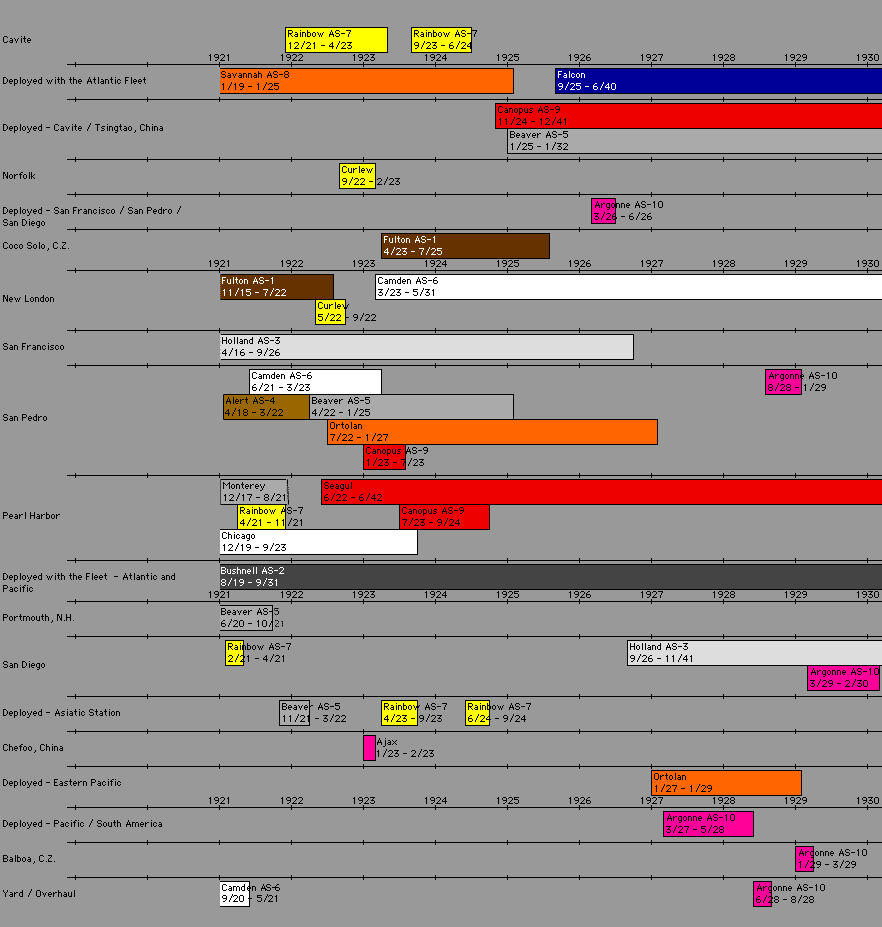
The 30's was a time when the US went through another of it's "isolationist" periods. The stock market crash at the end of the 20s had money very tight; the memory of the horrors of World War I was still fresh in the minds of many Americans; and we had a fairly large - and (at the time) fairly modern submarine force -- so many Americans wanted to just let the World go by it's self - where ever it was it wanted to go. By the end of the decade - with war already loose again in Europe - and the US becoming engaged in increasingly bitter disputes with Japan - some preparations for modernizing and increasing all of the US's military was put in place. Fortunately - most of the efforts into boosting the submarine fleet were well underway when Japan attacked Pear Harbor.
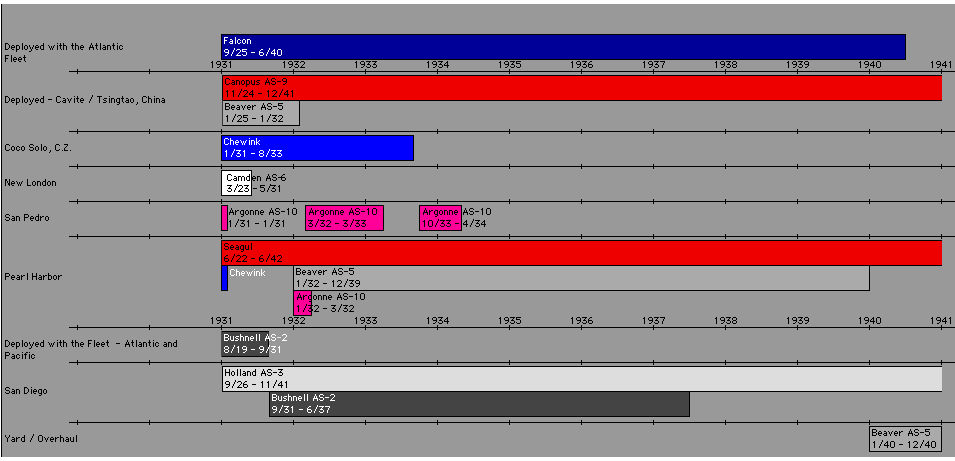
The Japanese attack o Pearl Harbor on December 7th, very late in 1941. Yet by that time the US's ability to deploy submarines was at an all time high - the raw number of subs and Tenders wasn't the point - but their capabilities were tremendous compared to the subs and Tenders of the last "great war". Further - with the program having been ramped up - many subs and Tenders were just about ready - and were able to be put into service early in 1942 - 10 Tenders were on line by the end of 1942 - in spite of loosing one at Cavite (the USS Canopus AS 9 was sunk by her crew rather than surrender her to the Japanese Navy). The USS Pigeon wasn't supposed to be a Tender - just didn't have any choice - as she too was caught at Cavite - and couldn't escape. Since the Canopus could not get underway - the Pigeon served as the "runner Tender" during those few months of holding off the Japanese invaders. As the Philippine Islands fell to the Japanese - the US had to move what assets it could out of harms way. The Holland (AS 3) was moved first to Java - then on to Port Darwin (the Holland had arrived just a few weeks before the Japanese started bombing). As the Japanese invasion progressed further - the US moved more of it's assets. Ships at Port Darwin / Fremantle were move either to Brisbane on Australia's eastern coast - some were recalled all the way to Pearl Harbor. 1943 shows this pull back with the concentrations at Pearl - and New Guinea. As the US halted - then began to beat back the Japanese advance - the deployments again began to spread out - and around the perimeter of the Japanese held territories. Finally - by 1945 - the entire Pacific was covered by deployed subs - and their Tenders - until Japan itself was occupied. As usual after winning a war - the US relaxed through the remaining years of the 40's decade - so that by the 50's - both boats and their Tenders were not exactly - state of the art. Boats were mothballed by the hundreds - Tenders fared little better -- six Tenders survived into the 50's.
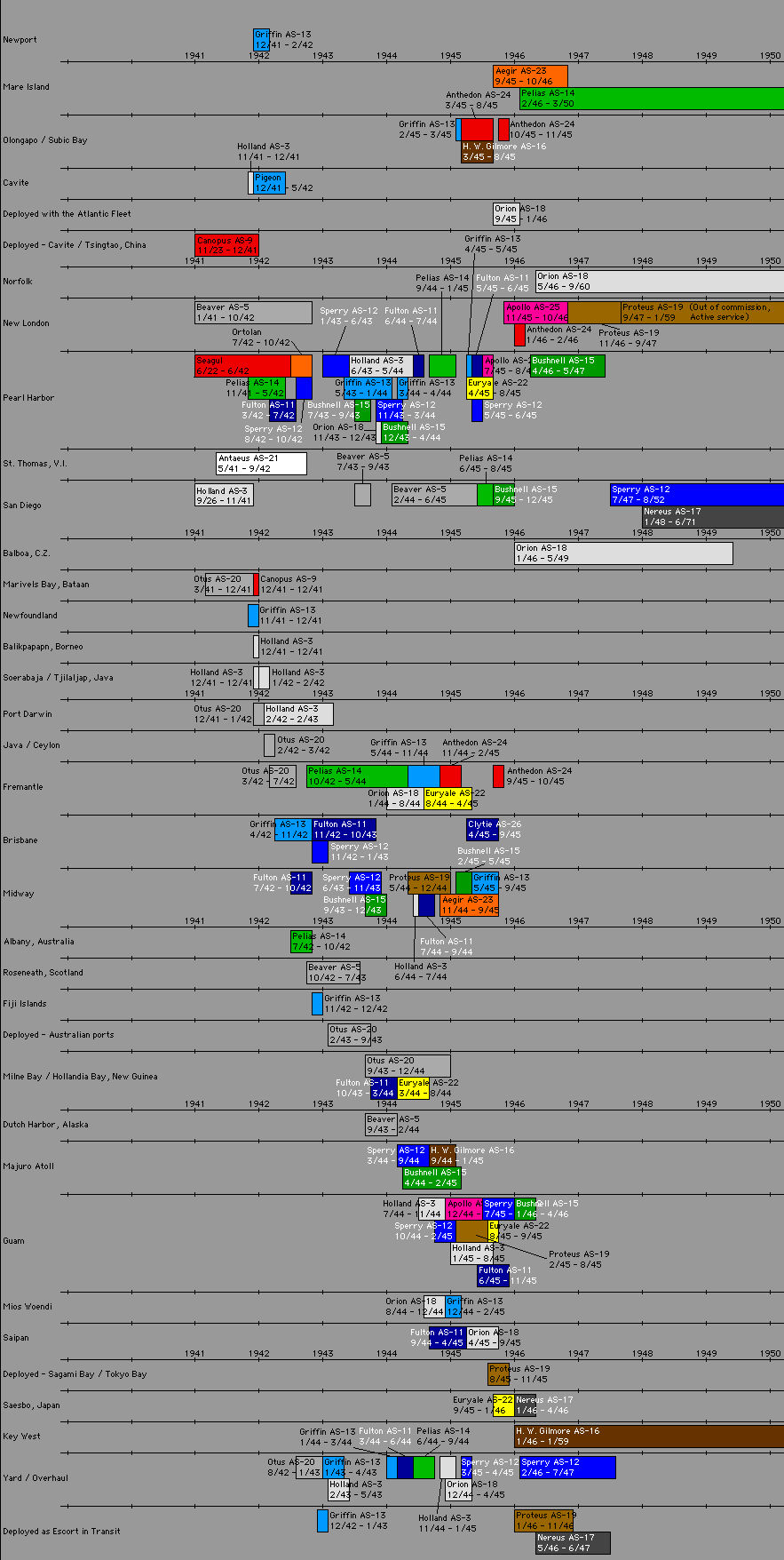
Actually - it was seven. While the Proteus was decommissioned - it was retained as an active reserve ship at New London - and serviced subs there through all but the last year of the decade. The Pelias was retired late 1950; however the Fulton was commissioned - and replaced it. One more time - there were NO overseas deployed subs - save for a short time during the Korean "conflict". The majority of the old boats weren't fit for service anymore - the US's submarine fleet fell from the status of the terror of the Pacific - to a (bad) joke. Fortunately - Hyman Rickover stepped in - and brought a new technology that would transform submarines from surface attack boats that could hide (briefly) under water - to true masters of the deep - and change sea power forever. Nuclear Propulsion would be the key to the next generation of subs - and of course - require new Tenders as well. You can see that the USS Proteus was moved from New London to Charleston in 1959 - this is a significant event in world history.
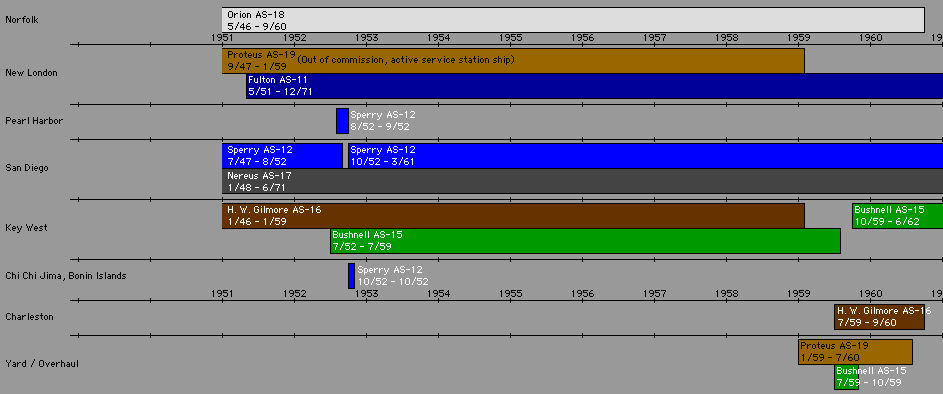
In the mid 50's - the Soviet Union had not only developed nuclear bombs - but had developed superior delivery systems - intercontinental missiles -- that the US couldn't match. Not even close. As noted - Rickover had brought nuclear propulsion to submarines - and that was a great advance. But with this new threat from the Soviet Union - what could the US counter with? The Air Force's new super bombers were still many, many years away - the Army certainly didn't have any delivery systems. But then there was the Navy. At the end of WWII - the US had found two surprises: 1) Japan had built a small fleet of submarines so big - that the hanger could house three airplanes. The sub could surface - launch it's planes right near their target (the US West Coast perhaps? - or the Panama Canal?) - then recover it's planes - submerge and disappear. 2) the Germans had the V1 and V2 rockets. While the US's rocket program hadn't advanced to as great a lifting capacity as the Soviets - the rockets were very accurate - and could do the job short range. So the US navy had been working with the idea of launching these types of weapons from a submarine. A sub could sit close to an enemy's shores - and launch short (but long enough) range missiles at them if the need arise. When Sputnik was launched - and it became clear just how large a threat Soviet missiles really were - the US had to find a way to counter the threat. And FAST. The Polaris missile system had been under development for some time - and Rickover's new nuclear powered subs were the platform of choice. So a new class of boat was designed - and of course Tender(s) to go along with them. When Sputnik beeped over our head, though - the construction time table proved way to long. The Answer? Take an existing sub being built - nearly completed. Cut it in half - add the missile tubes and supporting "stuff"... and you have the Polaris system - a couple of years sooner. So it was that the USS Scorpion SSN 598 was cut in half - the missile and supporting sections welded in - and she became the USS George Washington SSBN 598. But WAIT!!! we have to have a Tender TOO...! So it was that the USS Proteus AS 19 - that old WWII veteran was moved to Charleston, cut in half - it too received the "stuff" to support the missiles and nuclear system of the new class of boat... and in 1961 - the USS Proteus - at New London - made the first of thousands of refits of "boomers" by Tenders to come. The 60's time line provides an interesting look at these new systems coming on line - The Proteus goes to Holy Loch - opening that site. Relieved by the Hunley (the first purpose-built FBM Tender) - the Proteus (after an overhaul) opens Rota, Spain - shortly thereafter the new Tender USS Holland relieves Proteus there. So the Proteus transits to Agana, Guam - setting up the third FBM refit site in places where the Polaris missile has the reach to be a credible threat. By the end of the 60's - all four of the "purpose built" "boomer" Tenders have been built (Hunley AS13; Holland AS 32; Simon Lake AS 33; and Canopus AS 34) making a total of five (with Proteus AS 19) in service. It was decided in 1964 to cancel AS 35 - and keep the Proteus Active. By the mid 70's, the "boomer" tenders settle into a routine - 100's of refits - relieved for a little time off for overhaul - then relieve another Tender so they can do the same. Also during this time - as the fleet of boomers reaches it's peak (41 for Freedom) - some effort shifts to Fast Attacks - as new classes of Hunter-Killer Submarines take there place on the world stage. These boats are primarily to counter the Soviets - who by now have put in place their own "boomers" now threatening our lands. The Fast Attacks are equipped to find and follow the Soviet's boomers - with orders for a quick kill (before they can launch) should war break out. And of course - new Tenders are needed for these new subs. The USS L.Y. Spear (AS 36) was a new class of Fast Attack purpose-built Tenders - followed by the USS DIxon (AS 37). Due to cost cutting - the AS 38 was cancelled before construction was started in the late 60's.
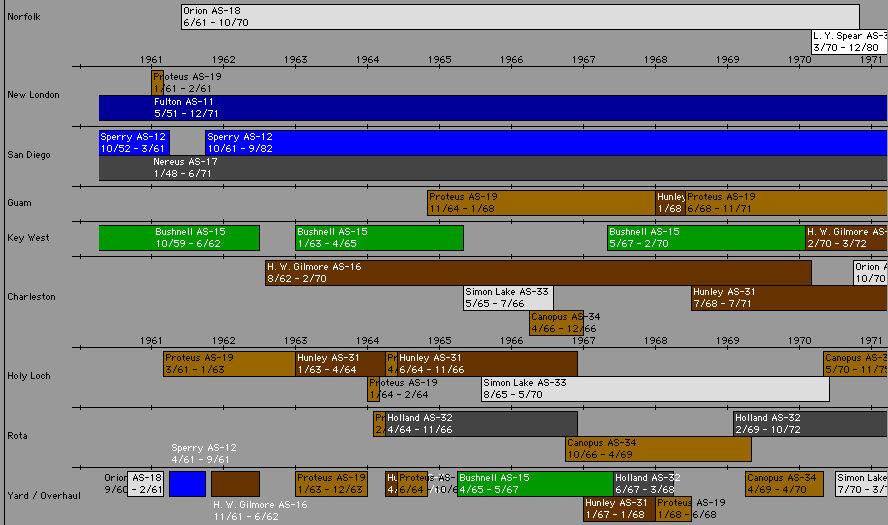
The late 70's saw another great leap in sub technology - which became the Los Angeles class - and of course - Tenders to service them - hence the last class of Submarine Tender is born - the Emory S. Land (AS 39). The Land is followed by the USS Frank Cable (AS 40) and the McKee (AS 41).
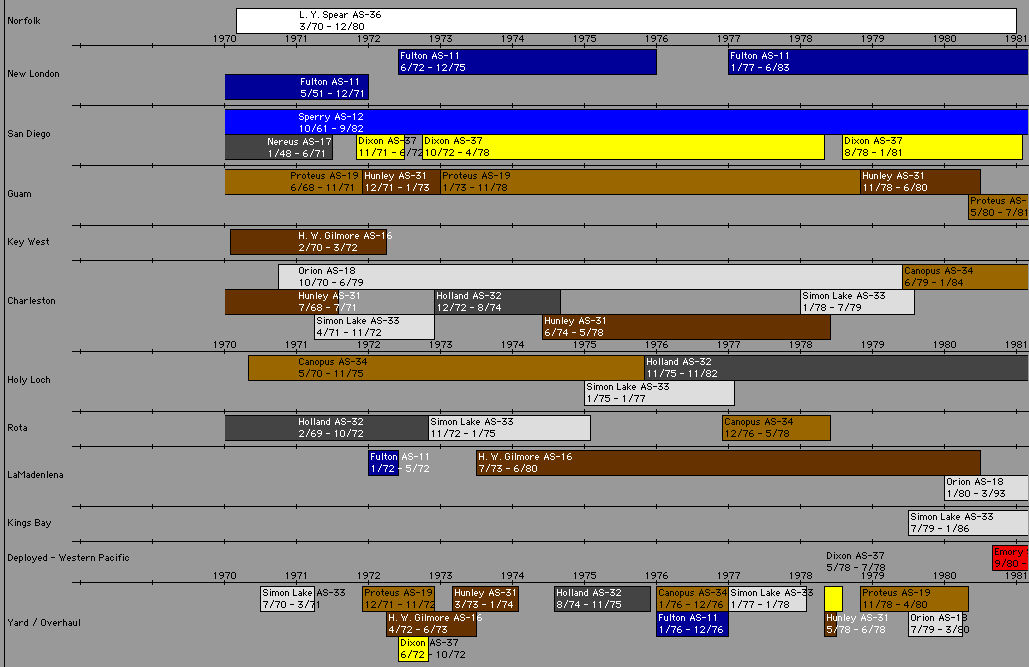
By the mid 80's - two new classes of boats are coming along - that will forever change the equation - these boats don't use Tenders. They are too big - too fast - have too much capacity - and their weapons too complex. They don't need to "deploy" over there - they are so fast they can leave home and be there in days instead of weeks. They are bigger than the Tenders - making it hard to service them - cranes don't reach - cranes may not have enough capacity. These boats can store years of supplies - instead of weeks of supplies. The sailor becomes the most often changed "critical component." With down-sizing more "popular" than ever - the Navy decides the FBM Tenders are obsolete.
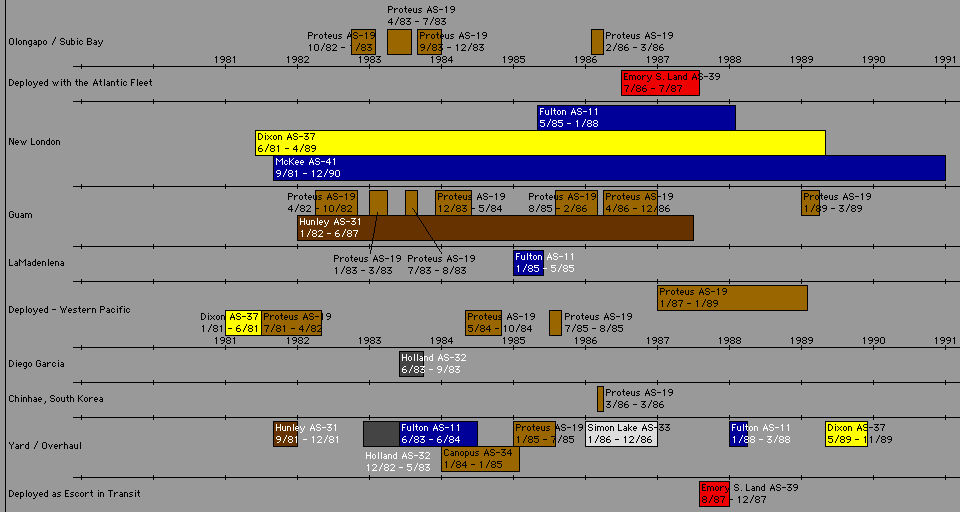
As the 90's come and go - so do many of the older submarines- leaving the newer - non "tender friendly" boats to carry on. During the 80's - as the new super boomers replaced older boats - a couple of the boomer Tenders were converted to service SSNs. Then as the newer fast attacks came along - both types of Tenders - FBM and Fast Attack -- were retired in record numbers. By the end of the Decade - the Century - even the newest Tender of all - the McKee (AS 41) had been retired.
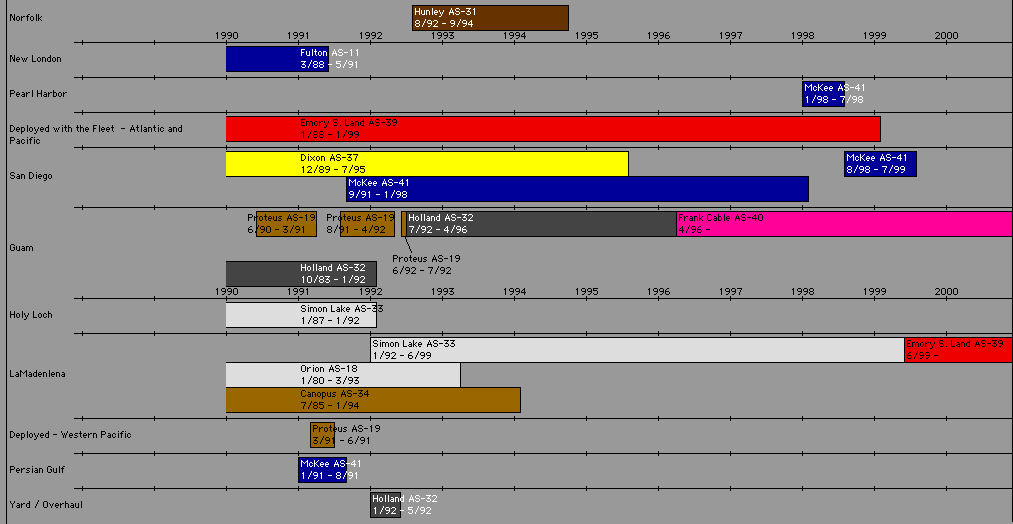
There is an old saying - what goes around - comes around - or put another way - history has a strange way of repeating itself. So it is with the US Navy Submarine Tenders -
"In the beginning: There were Two. In the end There are Two."
USS Emory S. Land is based at LaMaddalena, Italy; USS Frank Cable is based at Guam. The only remaining Tender Deployments are in the middle of the Pacific and the Middle of the Mediterranean Sea, NONE on either coast of the US.
Here is the entire chart in one piece: Some Browsers can not display a graphic this large, there is a link below - If you right click (click pause on Mac) and then SAVE AS - you can download it and view it with some other software such as media player or photoshop, etc.
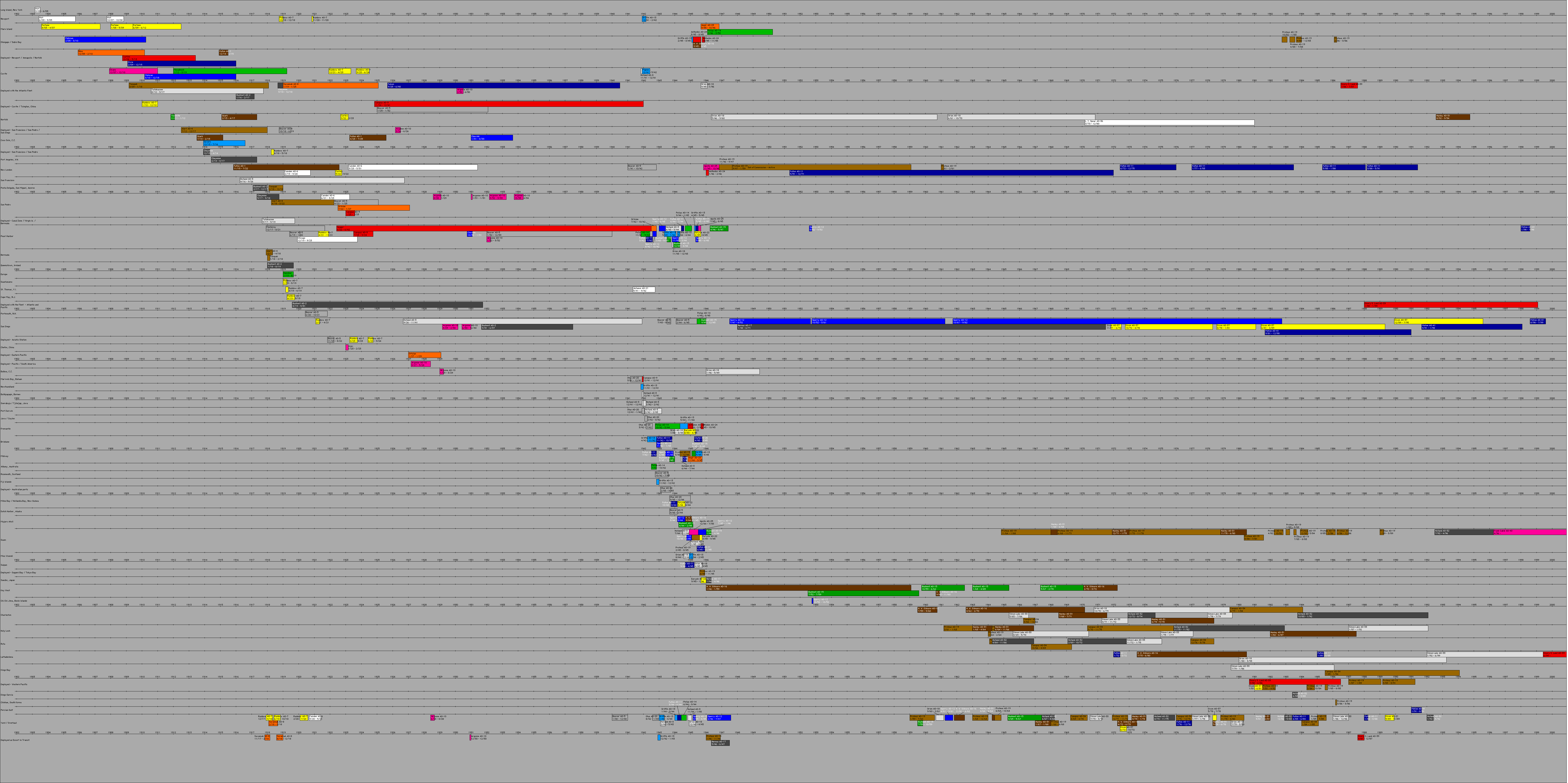
DownLoadClick Here to Download
Table of Contents
NOTE Tender TimeLine is © 2001 Common Cents Computers
ALL rights reserved










